the art of ruddell
 Ruddell Art Gallery 1: Magic Marker renderings, spray can paintings, ink applied with cloth. Jaguar Styling archives and quarter scale models. 10th scale wind tunnel models from the 60s.
Ruddell Art Gallery 1: Magic Marker renderings, spray can paintings, ink applied with cloth. Jaguar Styling archives and quarter scale models. 10th scale wind tunnel models from the 60s.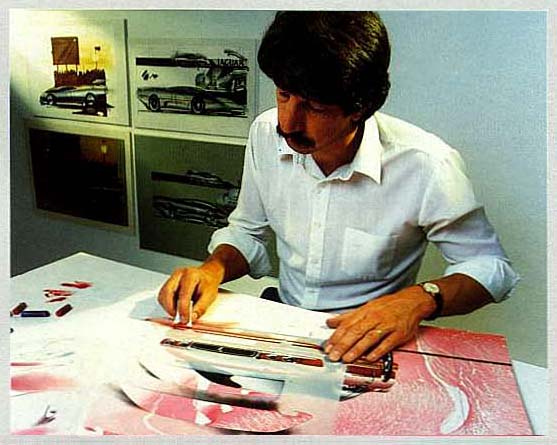
part of a rendering tutorial that appeared in the in-house "Jaguar Topics" magazine in 1989, showing me demonstrating the application of pastel with a cotton pad, and a drawing film mask. This is a technique I still use today.
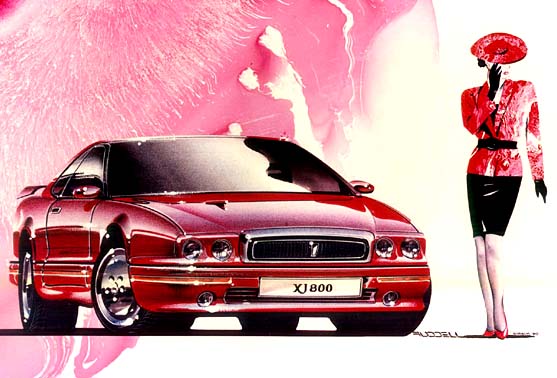
in 1986, before the XJ40 was launched, we looked at a 2 door coupe version of the car, as a total ground up re-skin
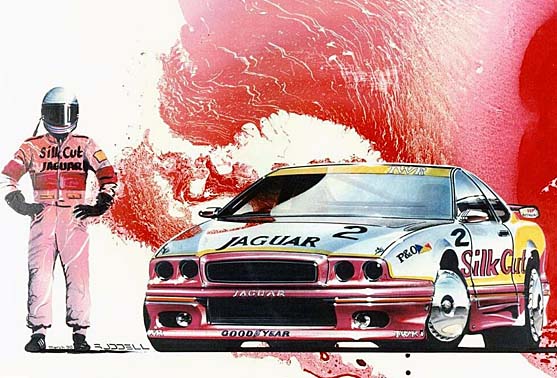
TWR's driver of choice Martin Brundle stands beside a competition version of the 2 Door: done in 1990 these two sketches were retrospective . .
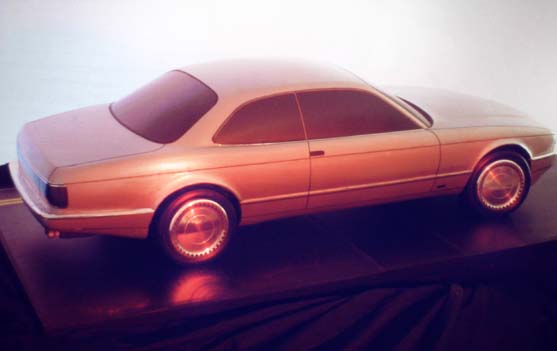
as the actual project took place in '85 and '86: the model here shows pillarless glass like the XJ6-C and the same wheelbase as the saloon
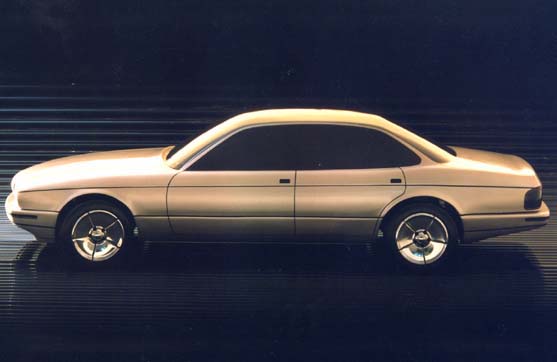 on the quarter scale GRP version of the design I taped it up as a 4 door, predating the XJ90 by several years, although I don't recall ever hearing the designation XJ90 until I read Nick Hull's book!
on the quarter scale GRP version of the design I taped it up as a 4 door, predating the XJ90 by several years, although I don't recall ever hearing the designation XJ90 until I read Nick Hull's book!
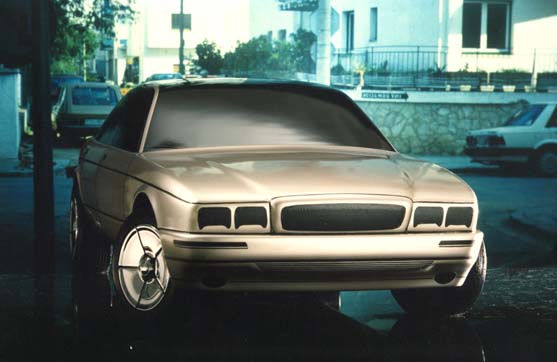 composite photography by Jaguar photographer Mick Cann in the days before Photoshop - back projected
35mm slides and multiple exposures . .
composite photography by Jaguar photographer Mick Cann in the days before Photoshop - back projected
35mm slides and multiple exposures . .
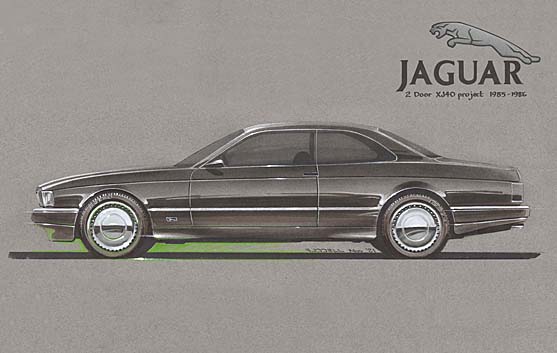 rendering of the finished design done as part of my retrospective in 2021, using the materials and media of the 80s
rendering of the finished design done as part of my retrospective in 2021, using the materials and media of the 80s
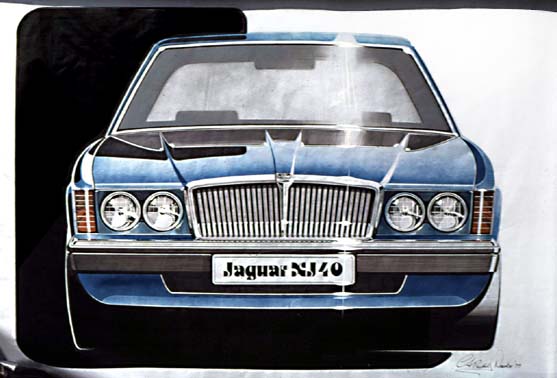
1 to 1 scale drawing done on the back of a dyeline print of a full size front elevation of the XJ40 clay model in 1979 - I reversed the print and traced the lines through, added some perspective for the cab, and used spray cans to colour in the picture.
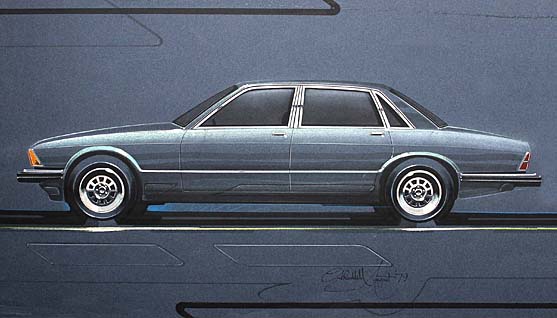 just discovered these in my archives - I thought these two drawings were long gone in the mid 80s clear outs when we moved to Whitley . . dated 1979 this version is very much of the 70s concepts we considered sans Jaguar "haunch"
just discovered these in my archives - I thought these two drawings were long gone in the mid 80s clear outs when we moved to Whitley . . dated 1979 this version is very much of the 70s concepts we considered sans Jaguar "haunch"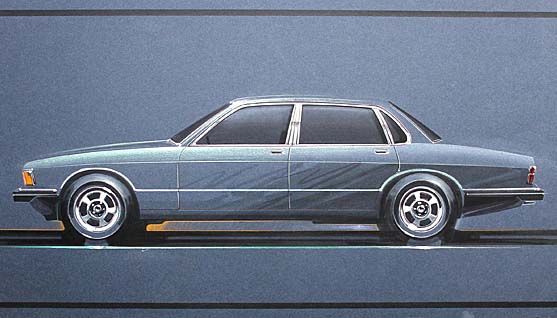 the haunch is back: the overall feel of this shape is pretty close to the production lines (next picture)
the haunch is back: the overall feel of this shape is pretty close to the production lines (next picture)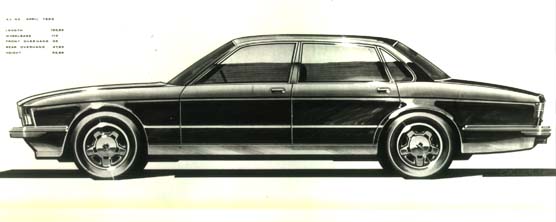 detailed side view sketch, at fifth scale, of the clay model in 1980 - the main lines remained unchanged
from this date up until the vehicle launch in 1986
detailed side view sketch, at fifth scale, of the clay model in 1980 - the main lines remained unchanged
from this date up until the vehicle launch in 1986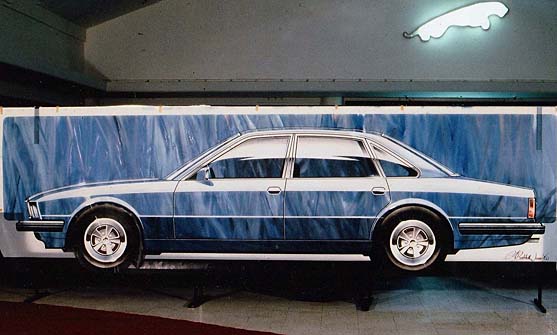 trying out the "ink on a cloth" method, after masking parts of the drawing out. This 1 to 1 scale rendering
was an alternative XJ40 body style, photographed in the Browns Lane showroom
trying out the "ink on a cloth" method, after masking parts of the drawing out. This 1 to 1 scale rendering
was an alternative XJ40 body style, photographed in the Browns Lane showroom 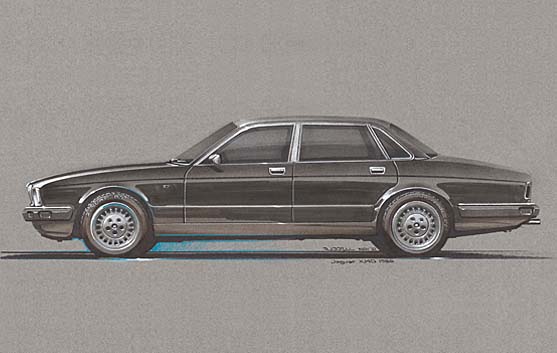 2021 and it's nice to draw the XJ40 for pleasure . . having drawn it so many times during it's design and development. Good memories of transferring body lines from the clay to the board!
2021 and it's nice to draw the XJ40 for pleasure . . having drawn it so many times during it's design and development. Good memories of transferring body lines from the clay to the board!
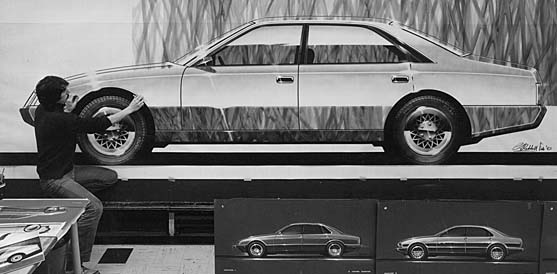 further rendering technique development on the XJ80 (mid size saloon): ink on cloth and then a traditional artists's airbrush for the wing shading; photographed by Mick Cann on Monday Feb 2nd 1981
further rendering technique development on the XJ80 (mid size saloon): ink on cloth and then a traditional artists's airbrush for the wing shading; photographed by Mick Cann on Monday Feb 2nd 1981
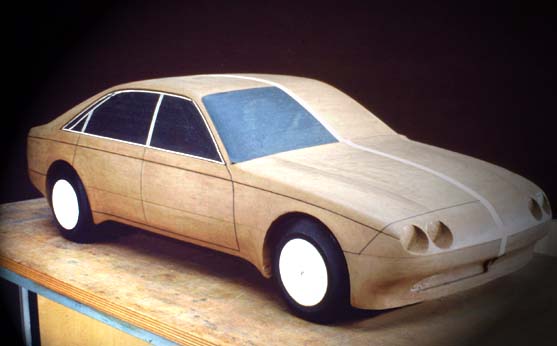 the XJ80 got as far as a quarter scale clay model but gradually ran out of steam in the early 80s, to be revisited in 1999 with the Jaguar S Type
the XJ80 got as far as a quarter scale clay model but gradually ran out of steam in the early 80s, to be revisited in 1999 with the Jaguar S Type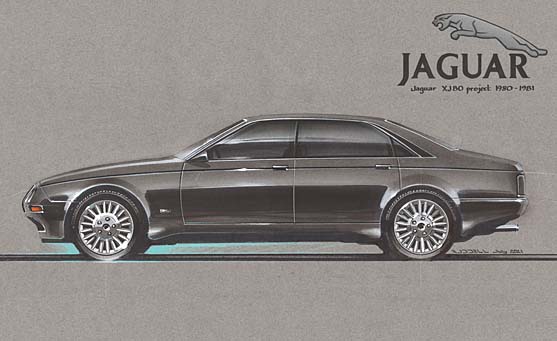 2021 recreation of the 80s concept renderings . . what the XJ80 could have looked like. It had Jaguar proportions but some of the details were a nod to the Ferrari Pinin concept unveiled at the 1980 Turin Motor Show.
2021 recreation of the 80s concept renderings . . what the XJ80 could have looked like. It had Jaguar proportions but some of the details were a nod to the Ferrari Pinin concept unveiled at the 1980 Turin Motor Show.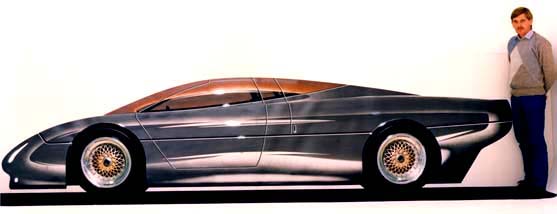 moving on from airbrushing I used car spray cans from Halfords! This meant that
there was no margin for error, but the benefits were great . . really intense colours.
Mick Cann stands by the drawing to demonstrate its scale.
moving on from airbrushing I used car spray cans from Halfords! This meant that
there was no margin for error, but the benefits were great . . really intense colours.
Mick Cann stands by the drawing to demonstrate its scale. 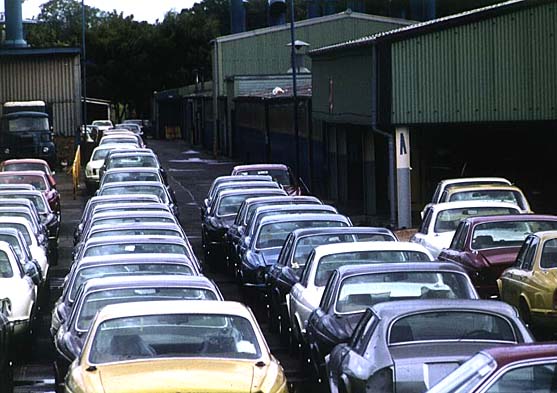 a normal day at the office . . the view right outside my office door, of the Jaguar factory in 1978 . . sadly it is now a housing estate.
a normal day at the office . . the view right outside my office door, of the Jaguar factory in 1978 . . sadly it is now a housing estate.
 the Mole
the Mole
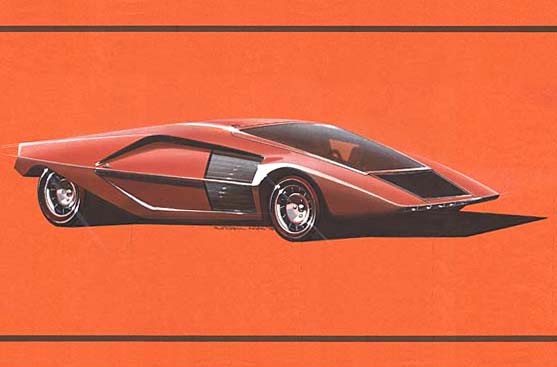 Bertone's absurd Stratos Zero concept which really captured our imagination. Drawn on orange canson paper in 1978 with magic marker, overlaid with pastel and white gouache.
Bertone's absurd Stratos Zero concept which really captured our imagination. Drawn on orange canson paper in 1978 with magic marker, overlaid with pastel and white gouache.
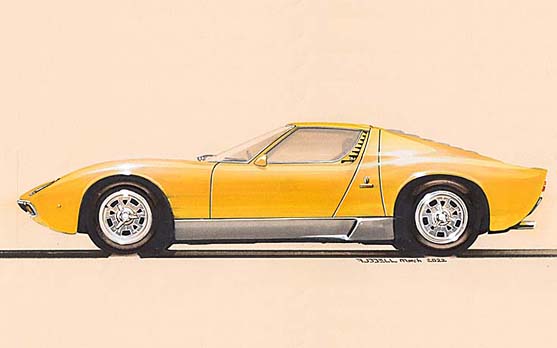
remembering Roger Zrimec's drawing demonstration he gave me in 1976, with yellow marker . . I was amazed!! Still trying to match his drawing perfection here with marker and pastel on Marcello Gandini's masterpiece, the 1966 Lamborghini Miura

completing my Marcello Gandini trilogy . . it's only taken 44 years haha! These three designs from Gandini's early period shadow what was to come with his Lamborghini Countach: slats, louvres and sharp edges!!
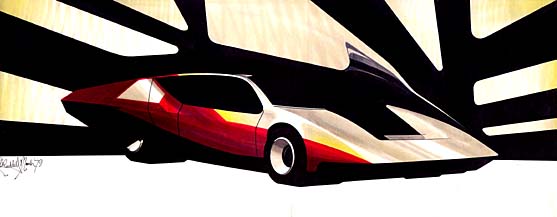 one of my first marker renderings - based on a Chris Field sketch from Vauxhall. This was a popular picture and I did several copies for people. I love the stark dramatic magic marker colours.
one of my first marker renderings - based on a Chris Field sketch from Vauxhall. This was a popular picture and I did several copies for people. I love the stark dramatic magic marker colours.
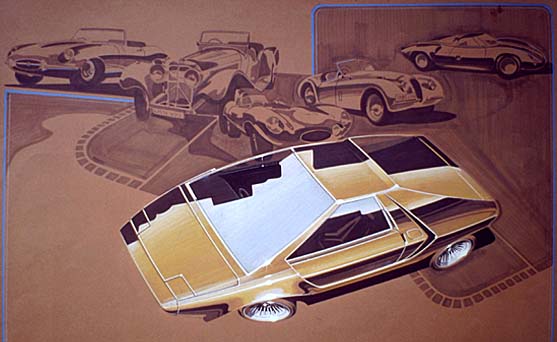 quite an early sketch - a new sports car heavily influenced by the Lotus Esprit I think, a nice collection of classic Jaguar sports cars in the background
quite an early sketch - a new sports car heavily influenced by the Lotus Esprit I think, a nice collection of classic Jaguar sports cars in the background
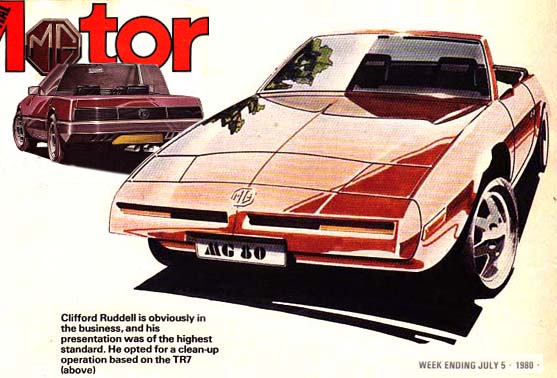 Several of us spent the 1980 Easter holidays entering a Motor magazine competition to design a new MG sports car. George Thomson won (inset) but the rest of us got a nice mention!
Several of us spent the 1980 Easter holidays entering a Motor magazine competition to design a new MG sports car. George Thomson won (inset) but the rest of us got a nice mention!
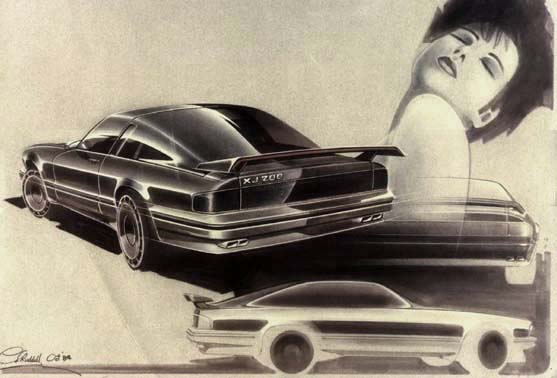 if you need to add human interest to a picture Isabella Rossellini has to be first choice . . . a bit of blue sky thinking on the XJ-S in 1984: Trans-Am style reverse curvature rear glass, and modified rear lamp treatment. The lamps made it onto the XJS Facelift in 1991 after I had left Jaguar
if you need to add human interest to a picture Isabella Rossellini has to be first choice . . . a bit of blue sky thinking on the XJ-S in 1984: Trans-Am style reverse curvature rear glass, and modified rear lamp treatment. The lamps made it onto the XJS Facelift in 1991 after I had left Jaguar
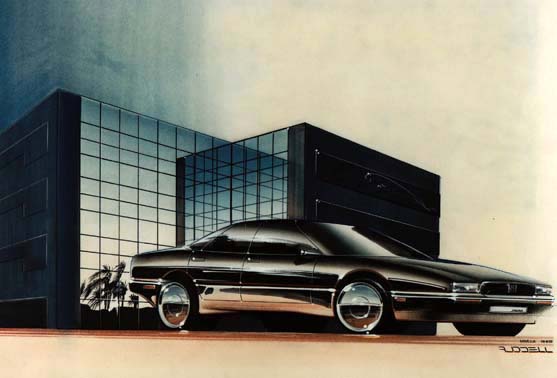 still looking at medium sized saloon ideas (an on-off-on project during the 80s): this one appeared in Marilyn Kenny's book "Design Graphics" in 1987
still looking at medium sized saloon ideas (an on-off-on project during the 80s): this one appeared in Marilyn Kenny's book "Design Graphics" in 1987
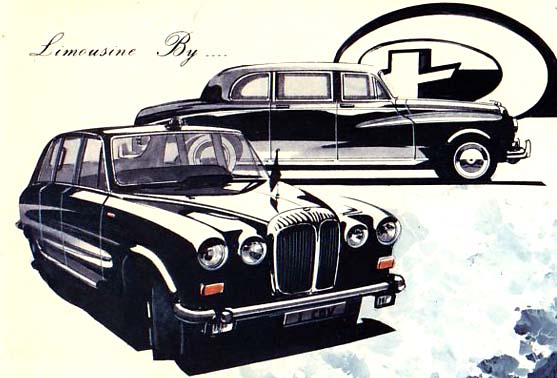 the Daimler DS420 Limousine was a milestone design, when it was released in 1968. After the contruction of a running prototype
under Sir William's direction, the lion's share of the body design was completed by Jack Dunnett in Body Engineering . .
the Daimler DS420 Limousine was a milestone design, when it was released in 1968. After the contruction of a running prototype
under Sir William's direction, the lion's share of the body design was completed by Jack Dunnett in Body Engineering . .
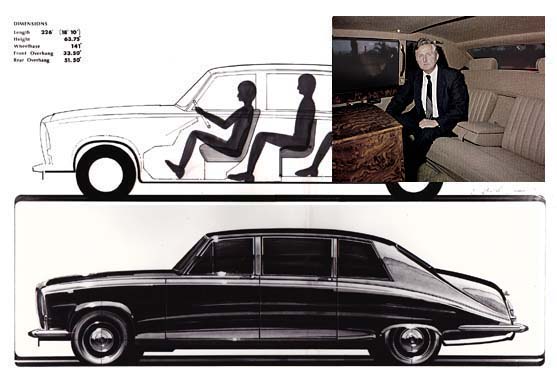 production moved from Park Sheet Metal/Kingsbury to Browns Lane in 1979 and thereafter the Limo manager Keith Cambage
(inset) commissioned several facelifts. Discussions of a complete replacement, however, took place in 1983 . . .
production moved from Park Sheet Metal/Kingsbury to Browns Lane in 1979 and thereafter the Limo manager Keith Cambage
(inset) commissioned several facelifts. Discussions of a complete replacement, however, took place in 1983 . . .
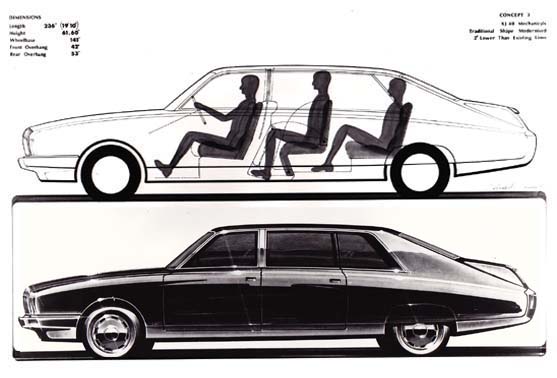 we produced some concept drawings of a modern limousine, based on the XJ40, the DS420 being based on the Mark X Jaguar. However, at only 3 hand built cars a week,
the limousine operation was soon no longer viable and production ceased in 1992 after 4116 cars had been
built.
we produced some concept drawings of a modern limousine, based on the XJ40, the DS420 being based on the Mark X Jaguar. However, at only 3 hand built cars a week,
the limousine operation was soon no longer viable and production ceased in 1992 after 4116 cars had been
built.
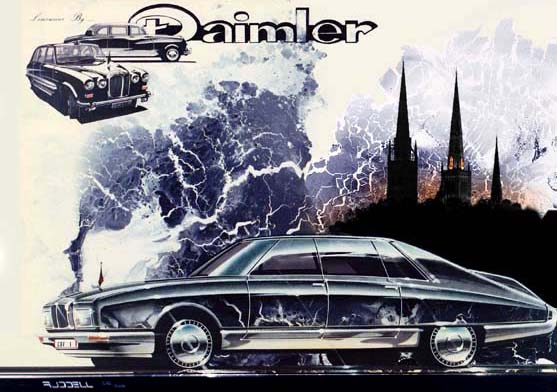 it could have been a spectacular vehicle echoing the DS420 theme. This image appears in Nick Hull's book Jaguar Design - a Story of Style, published Sept 2015.
it could have been a spectacular vehicle echoing the DS420 theme. This image appears in Nick Hull's book Jaguar Design - a Story of Style, published Sept 2015.
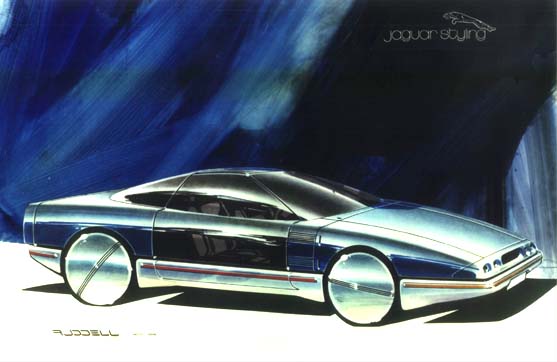 part of a rendering programme started in 1984 by Geoff Lawson when the unions were on strike and we had no clay modellers.
Geoff tasked us with creating some "neat sketches" of concept vehicles to be framed and circulated throughout the Executive Offices.
part of a rendering programme started in 1984 by Geoff Lawson when the unions were on strike and we had no clay modellers.
Geoff tasked us with creating some "neat sketches" of concept vehicles to be framed and circulated throughout the Executive Offices.
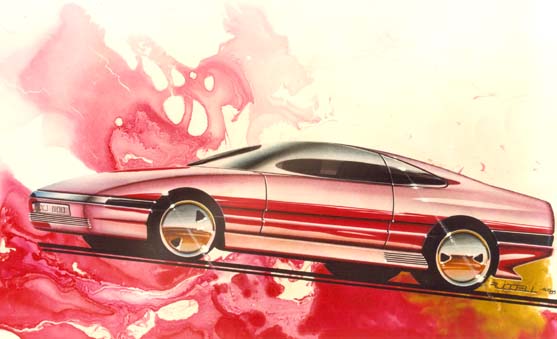 It was also Geoff Lawson's suggestion to stylise my signature which I have kept ever since.
It was also Geoff Lawson's suggestion to stylise my signature which I have kept ever since.
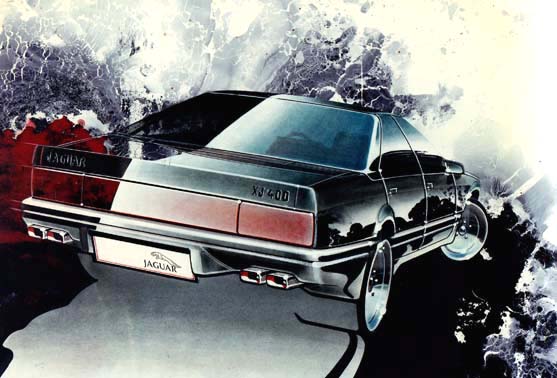 black flowmaster ink could be spectacular . . .
black flowmaster ink could be spectacular . . .
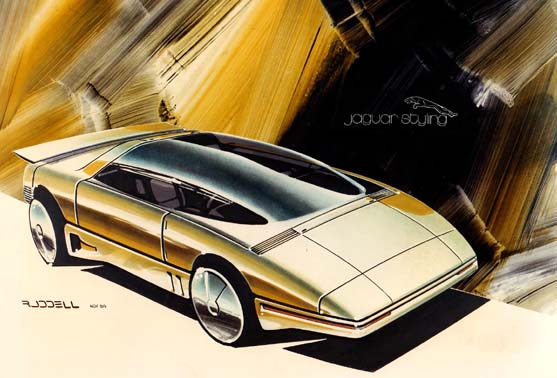 the "ink on a cloth" method, still using flowmaster inks, but applying them with a cloth onto drawing film - so same heady smell but a very different end result.
the "ink on a cloth" method, still using flowmaster inks, but applying them with a cloth onto drawing film - so same heady smell but a very different end result.
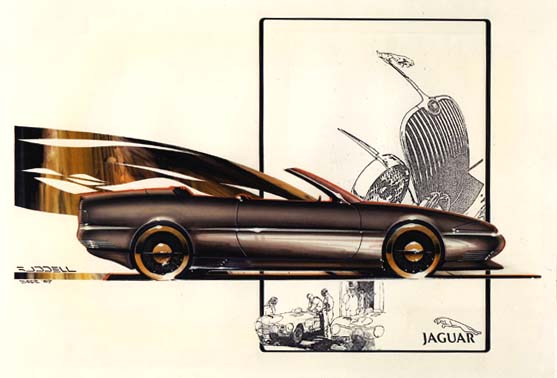 another popular format was to use a separate background to set the theme of the design.
another popular format was to use a separate background to set the theme of the design.
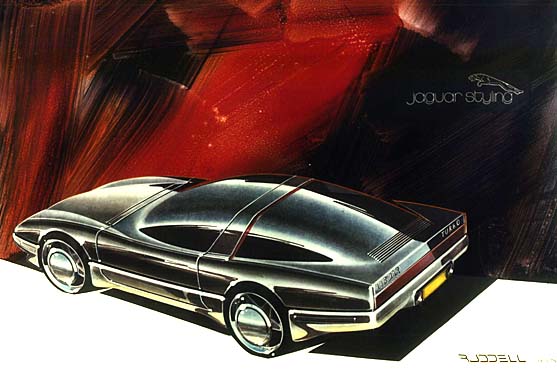 maybe some American influence here with double curvature glass after the style of the Trans Am
maybe some American influence here with double curvature glass after the style of the Trans Am
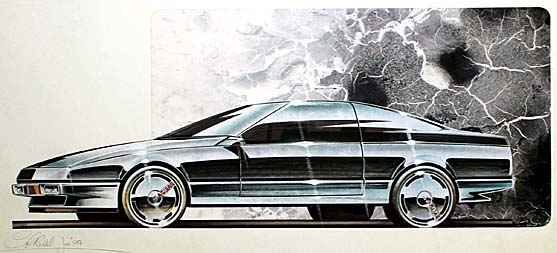 something . . . dated January 1984
something . . . dated January 1984
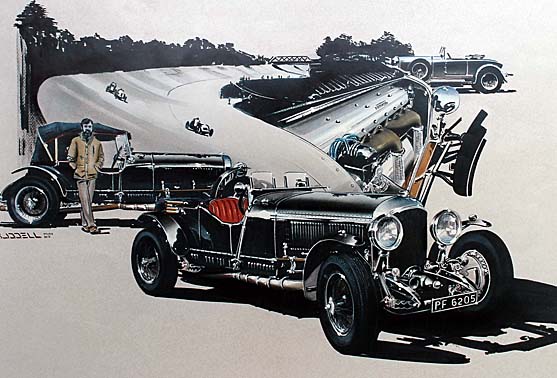 my Bentley and Rolls Royce period: this being a Bentley Speed Six, originally a boat tailed car, that actually competed at Brooklands in the 1930s, fully restored by Richard Cresswell between 1984 and 1988. This car appeared in an Autocar road test on 23rd November 1988.
my Bentley and Rolls Royce period: this being a Bentley Speed Six, originally a boat tailed car, that actually competed at Brooklands in the 1930s, fully restored by Richard Cresswell between 1984 and 1988. This car appeared in an Autocar road test on 23rd November 1988.
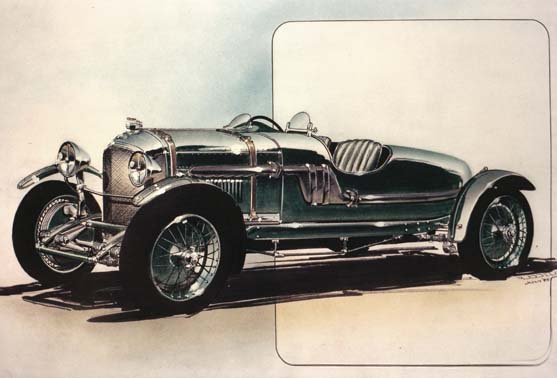 proposal for a one-off 4½ Litre Bentley special with a racing tail and a full Brooklands exhaust system
proposal for a one-off 4½ Litre Bentley special with a racing tail and a full Brooklands exhaust system
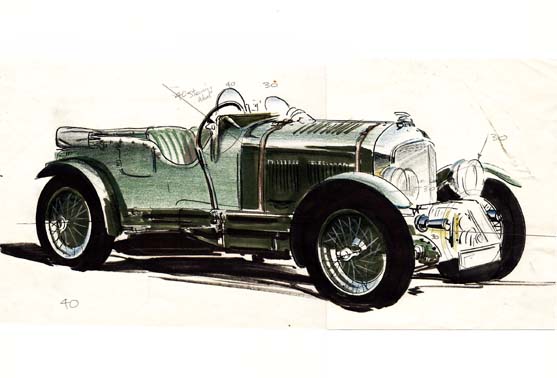 a working sketch, showing some drawing notations, based on a 4½ Litre Le Mans "Blower" Bentley
a working sketch, showing some drawing notations, based on a 4½ Litre Le Mans "Blower" Bentley
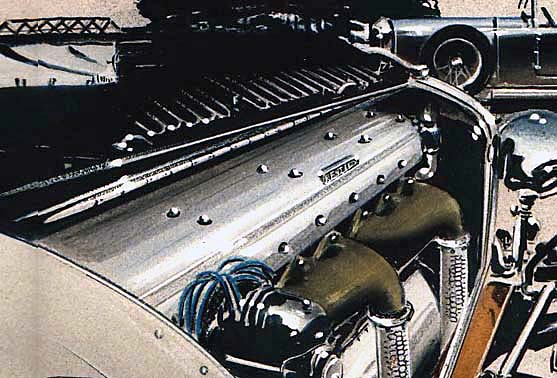 the 6½ litre engine of PF 6205 which has a Le Mans cam and 4 valves per cylinder to produce 200bhp at 3000rpm
the 6½ litre engine of PF 6205 which has a Le Mans cam and 4 valves per cylinder to produce 200bhp at 3000rpm
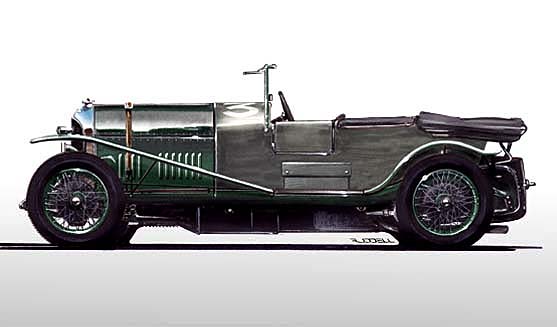 the 3 Litre Speed Bentley winner of the Le Mans 24 hours in 1927, known as Old No.7 . . after winning in 1924 this car started a run of 4 consecutive Le Mans victories.
the 3 Litre Speed Bentley winner of the Le Mans 24 hours in 1927, known as Old No.7 . . after winning in 1924 this car started a run of 4 consecutive Le Mans victories.
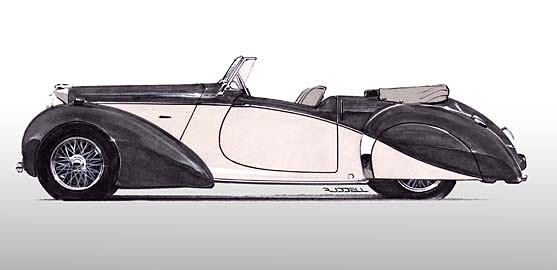 The mighty 4½ Litre Lagonda V12 Rapide, the project that was run by WO Bentley after he had left Rolls Royce. Styled by Frank Feeley, who would later do the DB Aston Martins.
The mighty 4½ Litre Lagonda V12 Rapide, the project that was run by WO Bentley after he had left Rolls Royce. Styled by Frank Feeley, who would later do the DB Aston Martins.
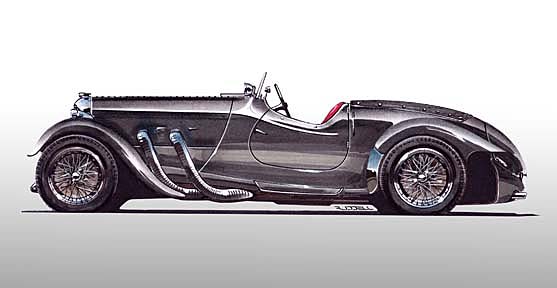 this and the previous picture were ads that ran in the 2015 Lagonda Owners Club magazine for VBE. This is 6 cylinder LG45. For 1937 this is a serious piece of styling!!
this and the previous picture were ads that ran in the 2015 Lagonda Owners Club magazine for VBE. This is 6 cylinder LG45. For 1937 this is a serious piece of styling!!
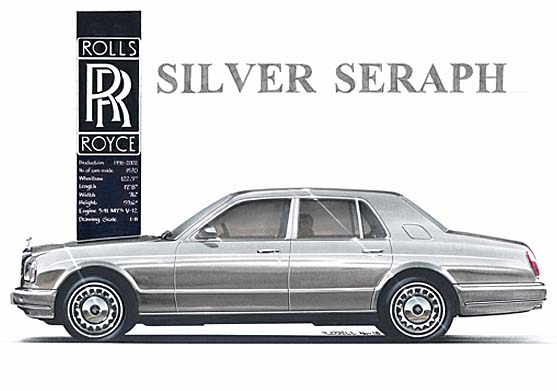 scale side view drawings were the bread and butter activities of the Body Drawing Office in the 1970s. With this Rolls Royce trilogy I am re-visiting those long forgotten skills, drawing on Ozalid film with a chisel point 2H pencil to create the vehicle specs
scale side view drawings were the bread and butter activities of the Body Drawing Office in the 1970s. With this Rolls Royce trilogy I am re-visiting those long forgotten skills, drawing on Ozalid film with a chisel point 2H pencil to create the vehicle specs
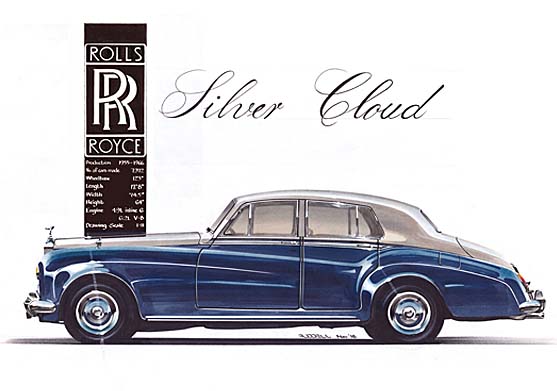 each drawing is exactly 1/11th scale and shows how the Rolls Royce style developed from the 40s to the 90s, with some overall dimensions remaining amazingly similar!
each drawing is exactly 1/11th scale and shows how the Rolls Royce style developed from the 40s to the 90s, with some overall dimensions remaining amazingly similar!
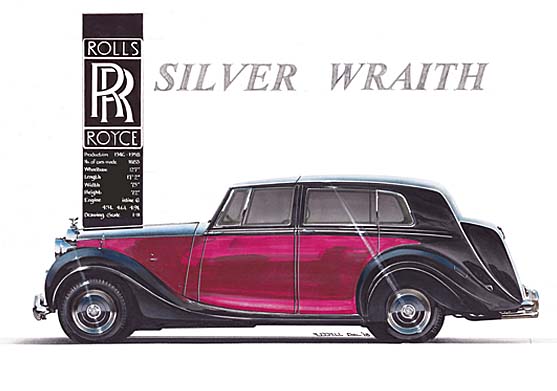 Magic marker techniques are used to complete the drawings, using the methods we employed in the 80s to sketch new concepts. All three pictures are available as A2 stretched canvas prints.
Magic marker techniques are used to complete the drawings, using the methods we employed in the 80s to sketch new concepts. All three pictures are available as A2 stretched canvas prints.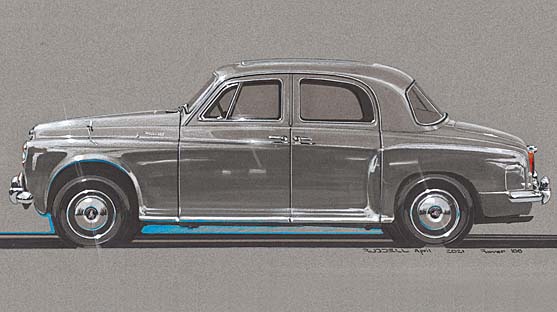
Back to the drawing method of the 70s - canson paper, magic marker and cumberland crayons . . using the paper colour as the basis for the car colour!
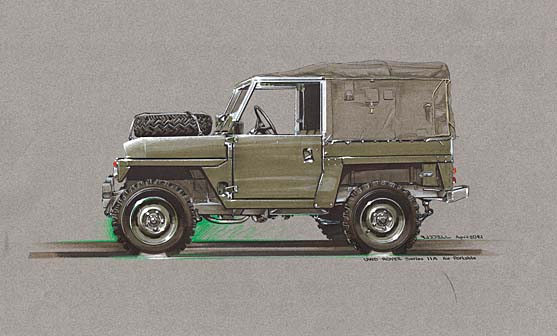
more 70s canson paper, magic marker and cumberland crayons . . the military adaption of the Land Rover IIA, the Air Portable, so called because it was a rapidly deployable 4×4 that could be slung under the Westland Wessex helicopter.
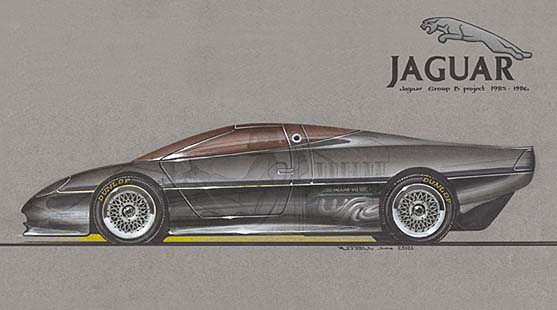
canson paper, magic marker and white gouache . . Scanned twice, before and after final shading: pulling the background forward a little with Photoshop!! Damn clever these Chinese!
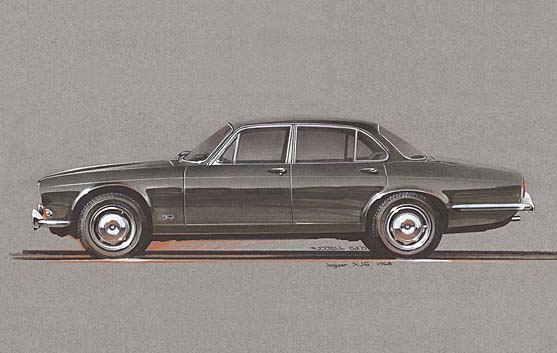 the wondrous Jaguar XJ6, just into production as I started my Jaguar Apprenticeship in August 1968. Who knew I'd still be drawing it's perfect lines 50 years on??! You can take the man out of Jaguar but you can't take Jaguar out of the man.
the wondrous Jaguar XJ6, just into production as I started my Jaguar Apprenticeship in August 1968. Who knew I'd still be drawing it's perfect lines 50 years on??! You can take the man out of Jaguar but you can't take Jaguar out of the man.
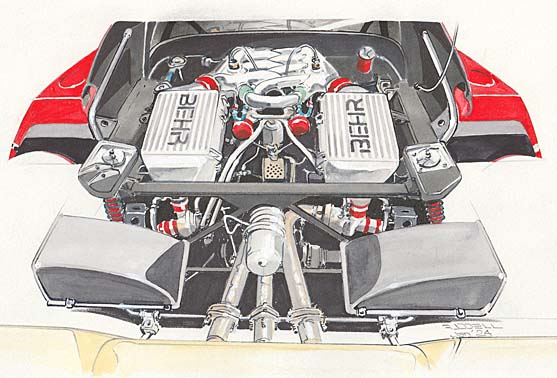 drawing of the prototype Ferrari F40 engine, with the fabricated inlet manifolds
drawing of the prototype Ferrari F40 engine, with the fabricated inlet manifolds
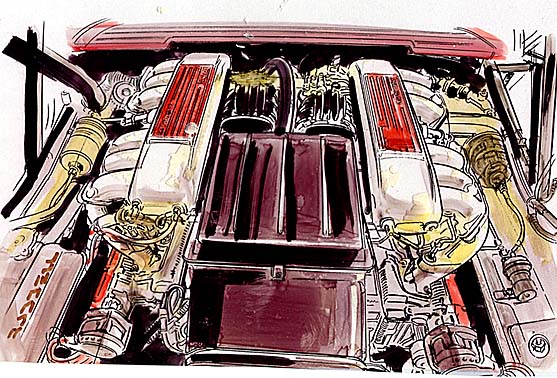 Ferrari Testarossa engine. Both these line drawings were printed out onto clear acetate and then hand tinted with magic marker.
Ferrari Testarossa engine. Both these line drawings were printed out onto clear acetate and then hand tinted with magic marker.
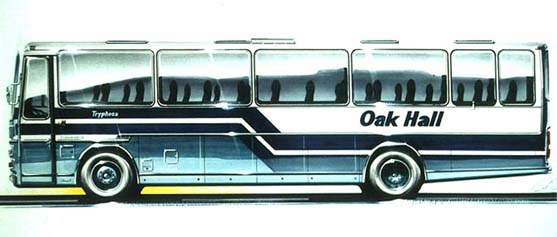 ski-ing expeditions in the Black Forest in 1979 - 1981 were courtesy of this Volvo Plaxton coach, which I rendered for some Oak Hall promotional material
ski-ing expeditions in the Black Forest in 1979 - 1981 were courtesy of this Volvo Plaxton coach, which I rendered for some Oak Hall promotional material
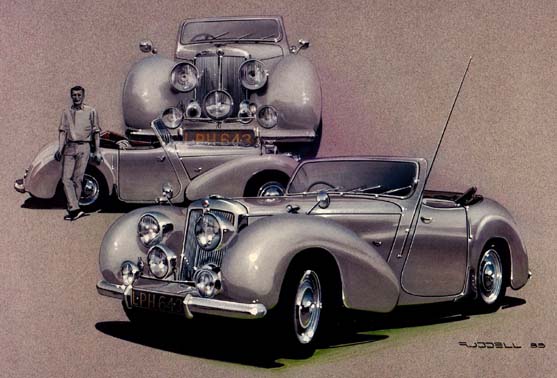 Triumph roadster drawing for a customer.
Triumph roadster drawing for a customer.
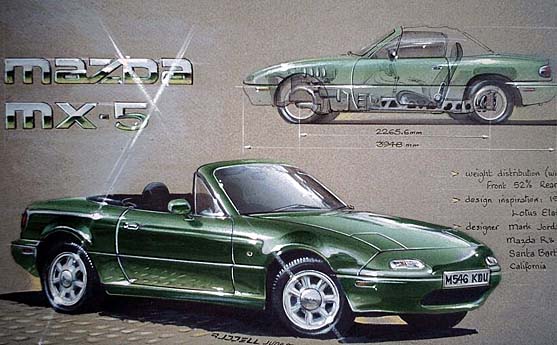 The Mazda MX-5, designed by Mark Jordan in the Santa Barbara Mazda studios. As I had driven an MX-5, worked in Santa Barbara and also met Mark's father, Chuck Jordan, I enjoyed connecting with this design.
The Mazda MX-5, designed by Mark Jordan in the Santa Barbara Mazda studios. As I had driven an MX-5, worked in Santa Barbara and also met Mark's father, Chuck Jordan, I enjoyed connecting with this design.
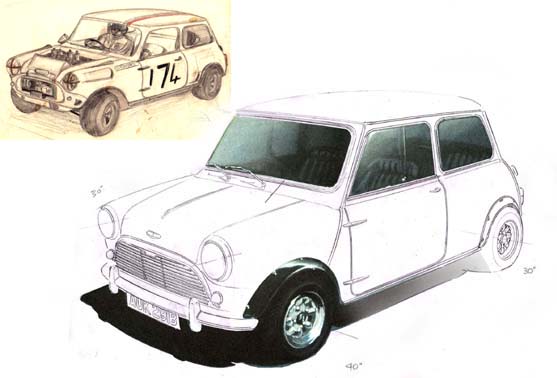 ever since I drew a Mini as a schoolboy ( inset ) I have wanted to do a decent sketch of a Mini so a commission to draw the restored AUK 291B was the perfect opportunity.
ever since I drew a Mini as a schoolboy ( inset ) I have wanted to do a decent sketch of a Mini so a commission to draw the restored AUK 291B was the perfect opportunity.
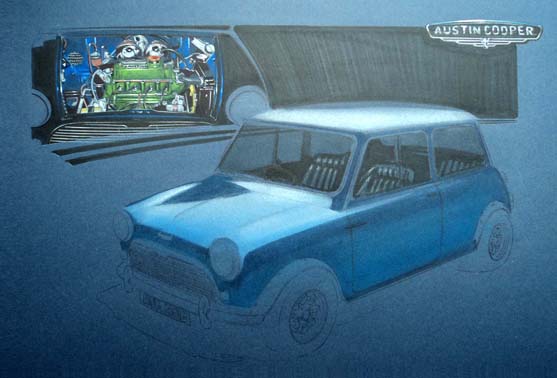 I laid the main blocks of colour down first, applied pastels with a cotton pad to bring out the reflective areas on the bonnet and roof.
Crayons were used to bring out the colour of the famous BS ( 381c ) Middle Bronze Green engine block!
I laid the main blocks of colour down first, applied pastels with a cotton pad to bring out the reflective areas on the bonnet and roof.
Crayons were used to bring out the colour of the famous BS ( 381c ) Middle Bronze Green engine block!
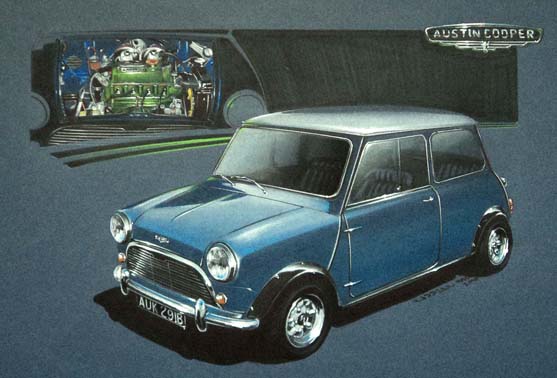 To finish the rendering off designer's gouche was used to create the highlights
To finish the rendering off designer's gouche was used to create the highlights
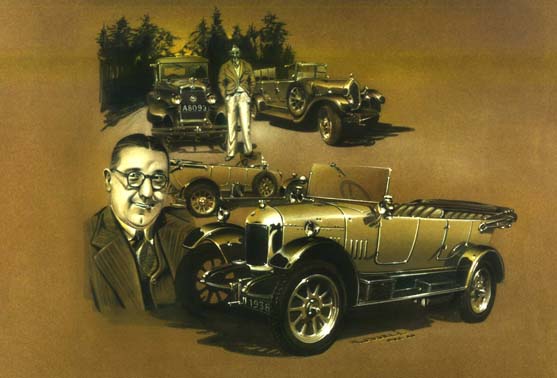 a drawing of my father done for his birthday, portraying the first three cars he owned in the 1920s
a drawing of my father done for his birthday, portraying the first three cars he owned in the 1920s
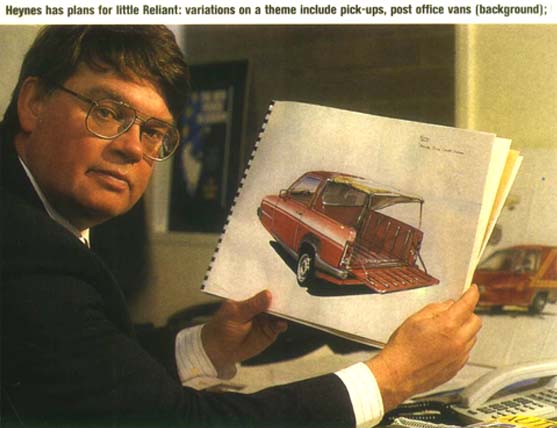 a book of Reliant Pick-up variations done for Jonathan Heynes when he took over Reliant. This picture appeared in an Autocar article on Reliant in January 1997
a book of Reliant Pick-up variations done for Jonathan Heynes when he took over Reliant. This picture appeared in an Autocar article on Reliant in January 1997
at the end of the report was this Product Plan summary
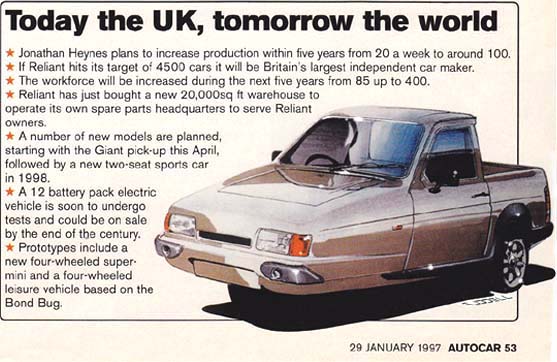
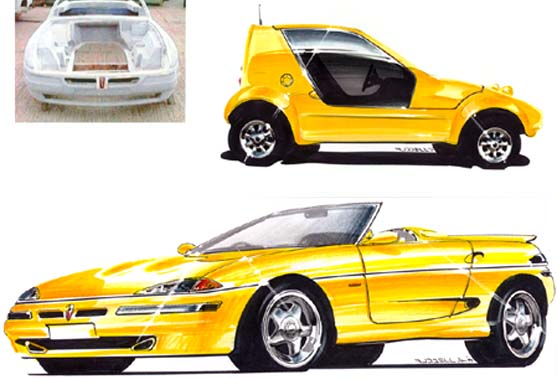 a 4 wheeler version of the Bond Bug, plus a stylish sports car based on a mysterious bodyshell
that Heynes discovered behind the factory, were ideas that were considered at the time . . .
a 4 wheeler version of the Bond Bug, plus a stylish sports car based on a mysterious bodyshell
that Heynes discovered behind the factory, were ideas that were considered at the time . . .
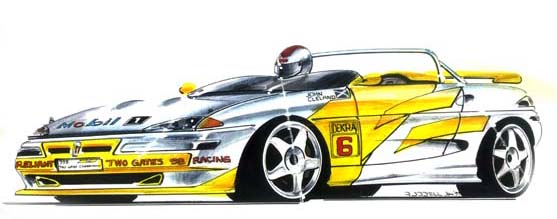 the competition version of the Reliant sports car . . .
the competition version of the Reliant sports car . . .
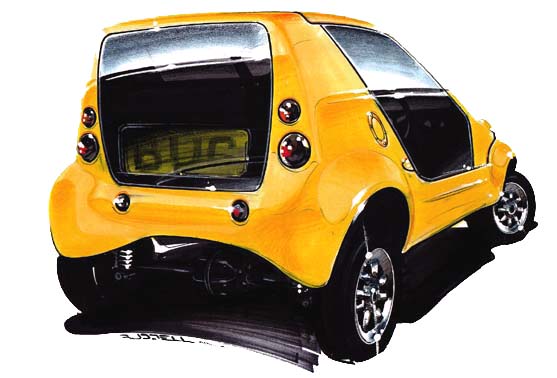 rear three quarter view of the 4 wheel BUG
rear three quarter view of the 4 wheel BUG
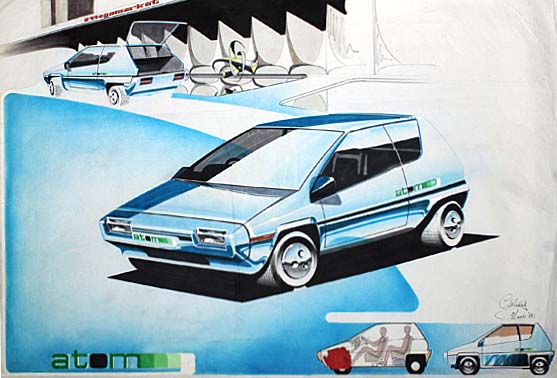 another small car project The Atom, part of a portfolio that I showed to GM in Detroit
another small car project The Atom, part of a portfolio that I showed to GM in Detroit
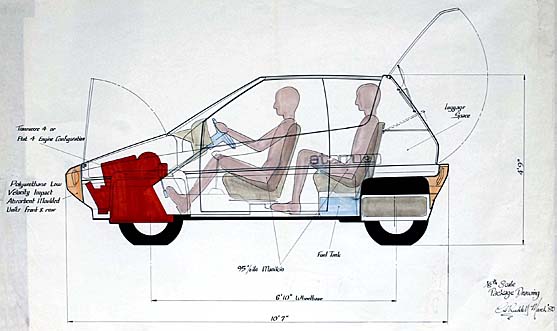 at 10' 7" it was nearly as short as the original Mini . . nearly . . .
at 10' 7" it was nearly as short as the original Mini . . nearly . . .
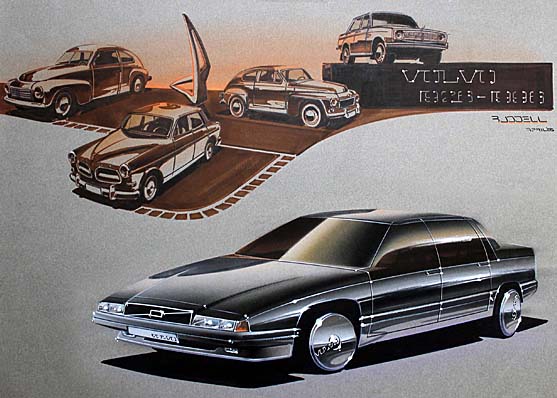 the Volvo period: Canewdon were recruiting a team to support Volvo Design in Gothenburg
the Volvo period: Canewdon were recruiting a team to support Volvo Design in Gothenburg
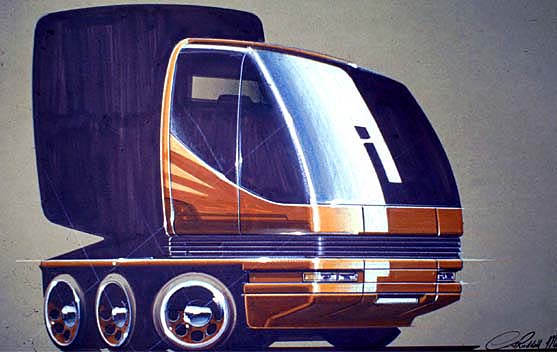 these were some renders I presented at the interview . . I didn't get the job; years later I demonstrated DesignConcept3D in the studios at Gothenburg . . it actually wasn't a bad place!
these were some renders I presented at the interview . . I didn't get the job; years later I demonstrated DesignConcept3D in the studios at Gothenburg . . it actually wasn't a bad place!
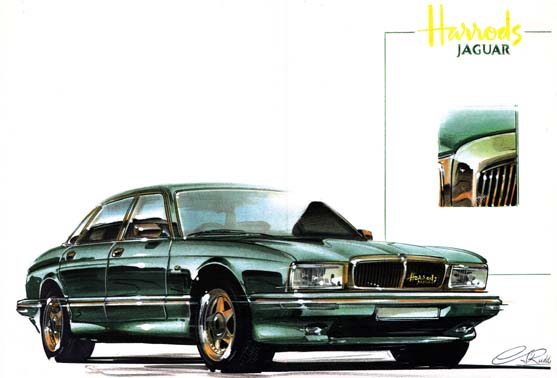 a Harrods version of the XJ6 - one of several renderings presented to Mohamed Al Fayed . . .
a Harrods version of the XJ6 - one of several renderings presented to Mohamed Al Fayed . . .
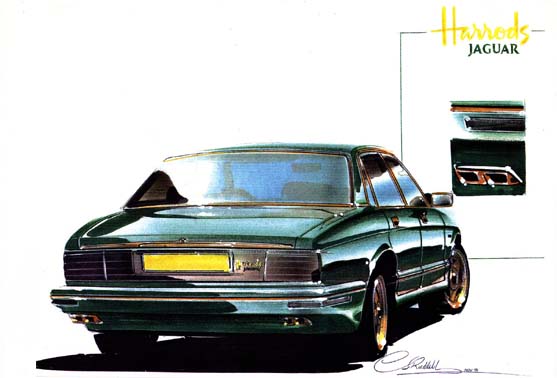 rear view of the Harrods XJ6
rear view of the Harrods XJ6
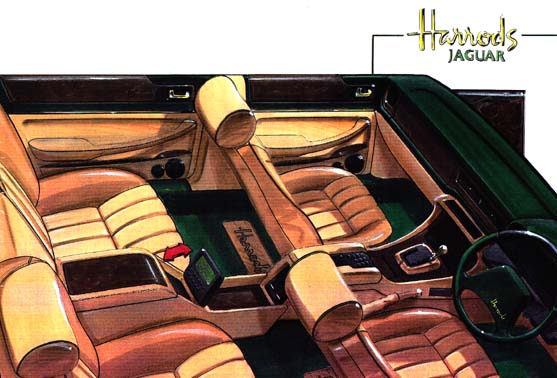 the Harrods XJ6 - I commissioned Iain Young to produce the interior style proposal and he did a fantastic job!
the Harrods XJ6 - I commissioned Iain Young to produce the interior style proposal and he did a fantastic job!
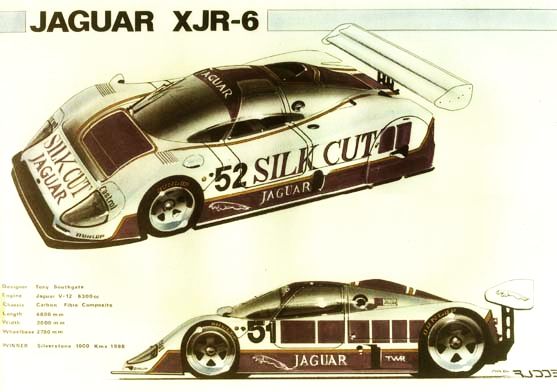 We had some involvement with the TWR XJR6 - submitting several Silk Cut graphics schemes.
We had some involvement with the TWR XJR6 - submitting several Silk Cut graphics schemes.
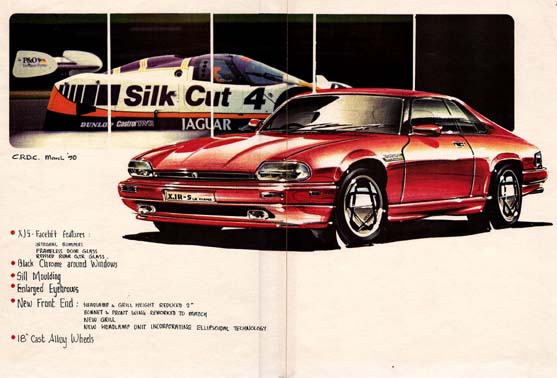 Jaguar Sport was still operated externally by TWR Engineering, who commissioned me to propose some facelift concepts for the XJS and XJ6
Jaguar Sport was still operated externally by TWR Engineering, who commissioned me to propose some facelift concepts for the XJS and XJ6
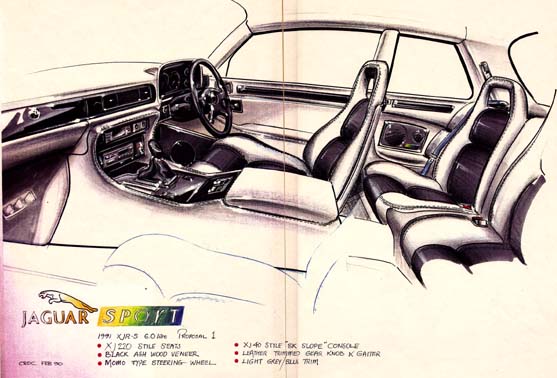 XJS revised interior with more of a competition theme.
XJS revised interior with more of a competition theme.
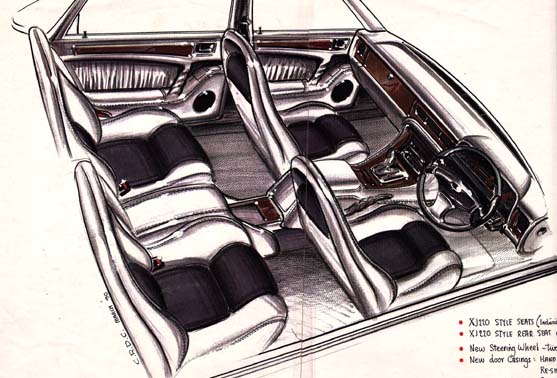 XJ6 revised interior with more of a competition theme. Both these schemes featured seats that leaned towards the style of the XJ220 seats.
XJ6 revised interior with more of a competition theme. Both these schemes featured seats that leaned towards the style of the XJ220 seats.
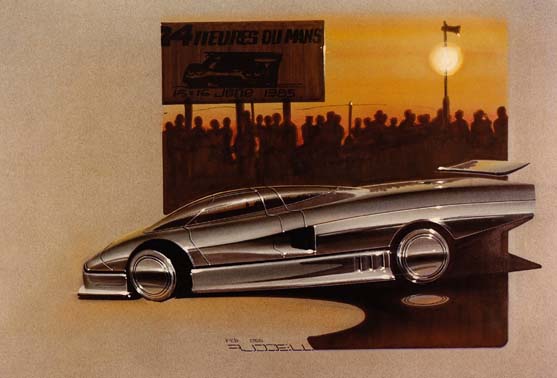 early ideas for the Group B Jaguar, this drawing shows the aerodynamic intent . . gradually rising upper surfaces, and sharply cut off air dam and sill sections
early ideas for the Group B Jaguar, this drawing shows the aerodynamic intent . . gradually rising upper surfaces, and sharply cut off air dam and sill sections
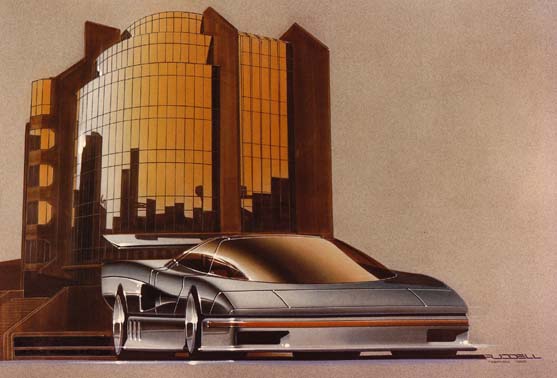 aimed primarily at racing, the shape had to be aerodynamically functional
aimed primarily at racing, the shape had to be aerodynamically functional
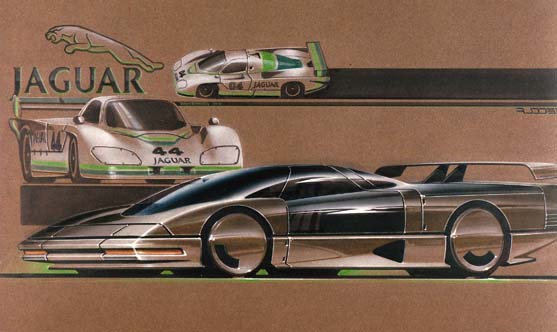 mid engined sports car done in 1984 some months before we started looking at a serious road going racing Jaguar, the Group B, this sketch appeared in Marilyn Kenny's book "Design Graphics" in 1987
mid engined sports car done in 1984 some months before we started looking at a serious road going racing Jaguar, the Group B, this sketch appeared in Marilyn Kenny's book "Design Graphics" in 1987
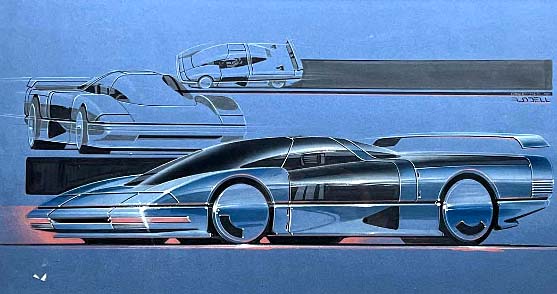 copy of the above drawing done for a client after removing the Jaguar branding from the image. Haven't seen this render for 35 years . . interesting colours!!
copy of the above drawing done for a client after removing the Jaguar branding from the image. Haven't seen this render for 35 years . . interesting colours!!
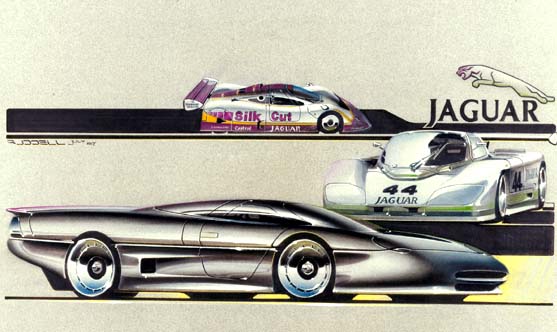 finished design proposal - this picture appeared in the Japanese magazine CAR STYLING in
March 1989 where it was commented on that it showed "Group C overtones ". . . now I wonder why that was?!
finished design proposal - this picture appeared in the Japanese magazine CAR STYLING in
March 1989 where it was commented on that it showed "Group C overtones ". . . now I wonder why that was?!
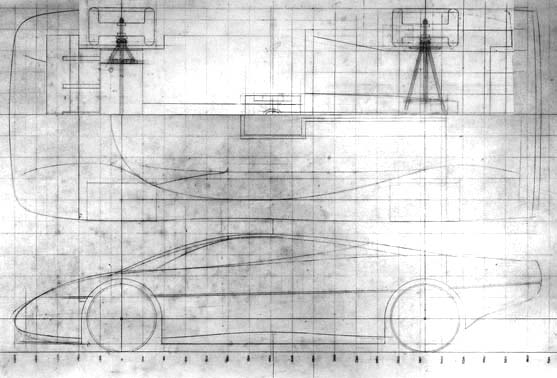 quarter scale drawing of the Group B wind tunnel model into which we incorporated the mounting structure requested by M.I.R.A
quarter scale drawing of the Group B wind tunnel model into which we incorporated the mounting structure requested by M.I.R.A
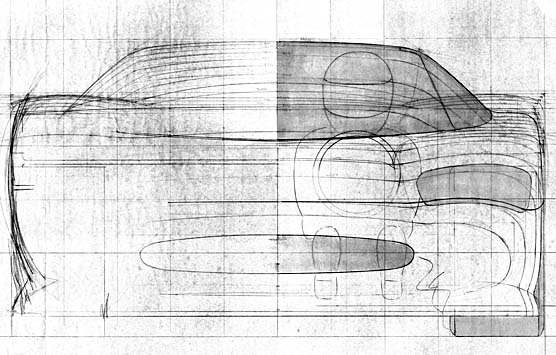 a nice front view from the quarter scale drawing of the Group B wind tunnel model. This has been lost for many years but just turned up wrapped inside another print!!
a nice front view from the quarter scale drawing of the Group B wind tunnel model. This has been lost for many years but just turned up wrapped inside another print!!
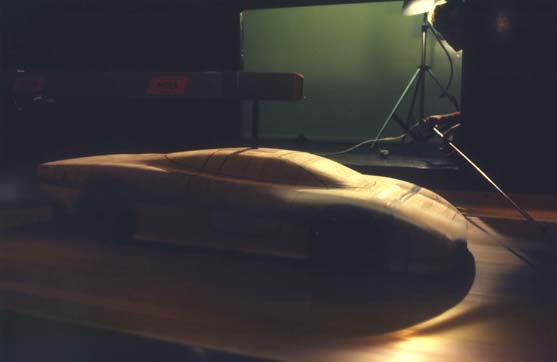 assessing the shape - the first Group B quarter scale model running in the M.I.R.A. moving road wind tunnel: still with model mounted wheels and suspension at this point . .
assessing the shape - the first Group B quarter scale model running in the M.I.R.A. moving road wind tunnel: still with model mounted wheels and suspension at this point . .
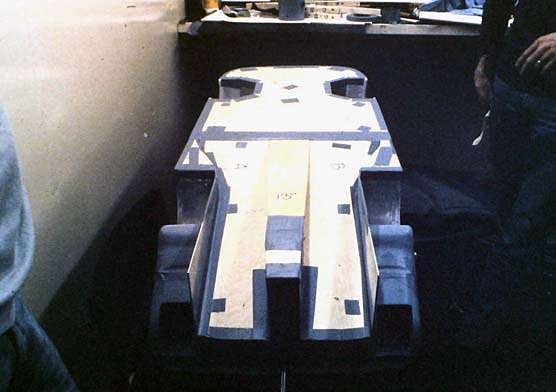 part way through the diffuser development. We ran three different angles of "venturi" and then cross matched the effect of different ride heights and different radiator configurations . .
part way through the diffuser development. We ran three different angles of "venturi" and then cross matched the effect of different ride heights and different radiator configurations . .
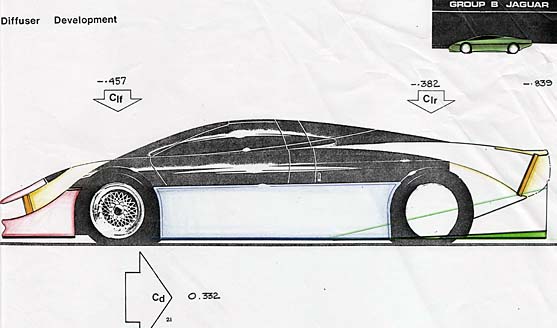 with air speed of 90mph in the scale wind tunnel, and a moving belt running at the same speed we were able to measure cl, the coefficient of lift (hopefully with a negative value!!)
with air speed of 90mph in the scale wind tunnel, and a moving belt running at the same speed we were able to measure cl, the coefficient of lift (hopefully with a negative value!!)
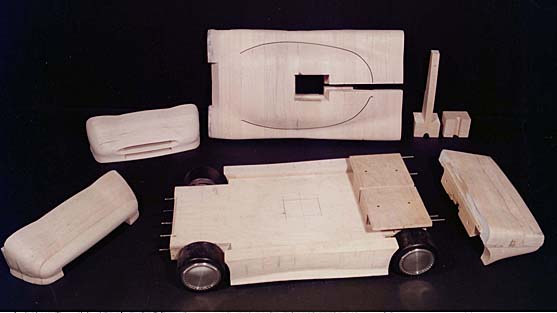 the Group B quarter scale model was modular so that we could try different nosecones, various sill sections and alternative tail sections
the Group B quarter scale model was modular so that we could try different nosecones, various sill sections and alternative tail sections
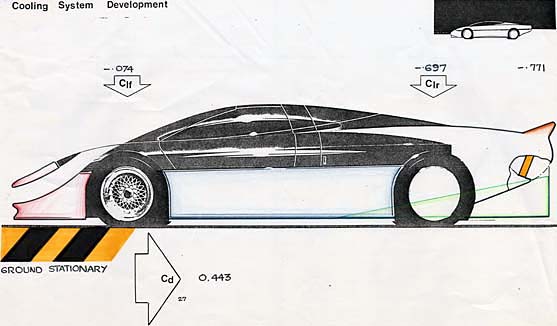 using scale radiator matrices fitted with pitot tubes we measured the effect of oil coolers and water radiators - we even fed the side radiators into the diffuser, which we called "base bleed" but would become known as "double diffuser" in 2009 with the Brawn F1 team!!
using scale radiator matrices fitted with pitot tubes we measured the effect of oil coolers and water radiators - we even fed the side radiators into the diffuser, which we called "base bleed" but would become known as "double diffuser" in 2009 with the Brawn F1 team!!
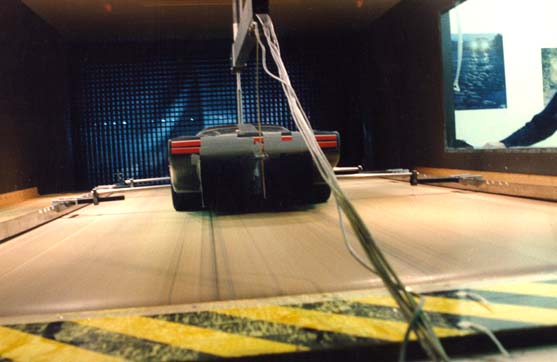 ground effect does work - our most extreme diffuser proposals sucked the belt off the rollers and brought
the windtunnel to a grinding halt. The same thing happened during the scale model development of
Team Lotus' Type 78. Today's Formula One teams use a steel belt . . .
ground effect does work - our most extreme diffuser proposals sucked the belt off the rollers and brought
the windtunnel to a grinding halt. The same thing happened during the scale model development of
Team Lotus' Type 78. Today's Formula One teams use a steel belt . . .
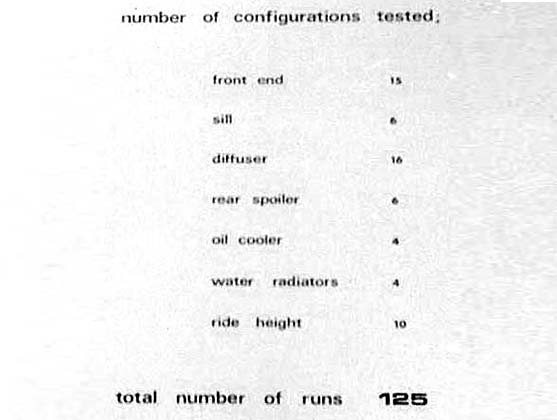 just unearthed this summary of the wind tunnel tests . . that's a serious number of runs. Of course this was all done in a few spare Saturday mornings haha . .
just unearthed this summary of the wind tunnel tests . . that's a serious number of runs. Of course this was all done in a few spare Saturday mornings haha . .
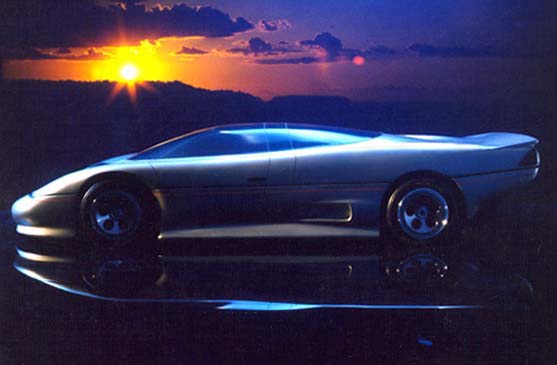 Quarter scale model photoshoot at Cape Royal, on the north rim of the Grand Canyon, as sun sets!
Quarter scale model photoshoot at Cape Royal, on the north rim of the Grand Canyon, as sun sets!
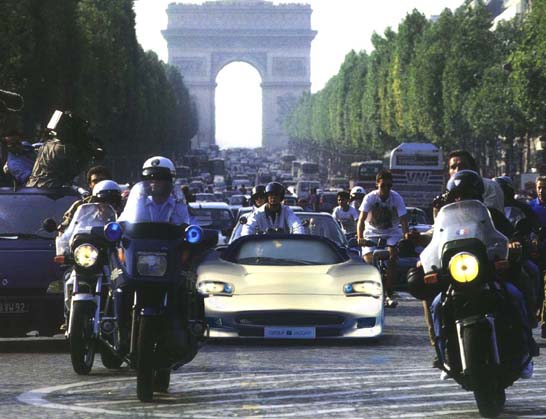 the Group B Jaguar makes its way down the Champs Elysees amidst great adulation . . . . haha if only
the Group B Jaguar makes its way down the Champs Elysees amidst great adulation . . . . haha if only
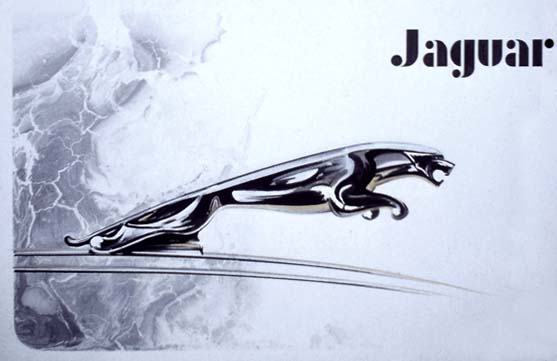 The leaping Jaguar - painted in mainly black gouache on top of black flowmaster . . on artboard.
The leaping Jaguar - painted in mainly black gouache on top of black flowmaster . . on artboard.
some other stuff, working drawings and unfinished renders . .
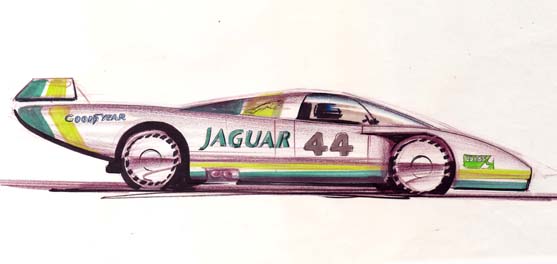 a Group B racing Jaguar was very much on my mind at the time these sketches were done, around 1985
a Group B racing Jaguar was very much on my mind at the time these sketches were done, around 1985
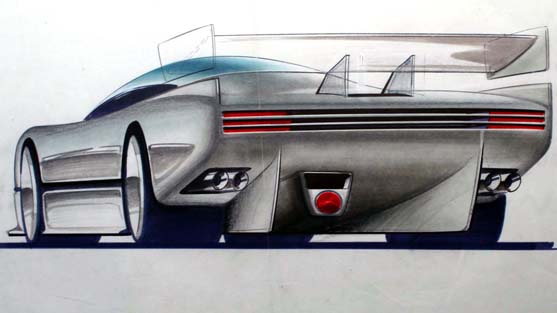 sketch showing the rear diffuser area of the car: the concept was that the entire car was an inverted wing profile that accelerated the airflow and created low pressure beneath the car, in accordance with the Bernoulli principle, that effectively "sucked" the car towards the road.
sketch showing the rear diffuser area of the car: the concept was that the entire car was an inverted wing profile that accelerated the airflow and created low pressure beneath the car, in accordance with the Bernoulli principle, that effectively "sucked" the car towards the road.
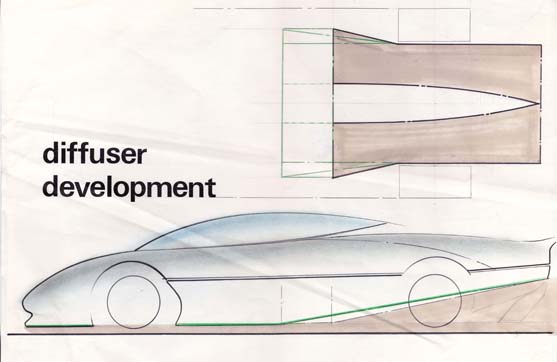 a scale "schematic" showing the diffuser area of the car floor from 2 angles. Very much a broad brush strokes approach until we could get the model onto the moving ground wind tunnel and get some real data back from testing. (Pictures shown further up gallery)
a scale "schematic" showing the diffuser area of the car floor from 2 angles. Very much a broad brush strokes approach until we could get the model onto the moving ground wind tunnel and get some real data back from testing. (Pictures shown further up gallery)
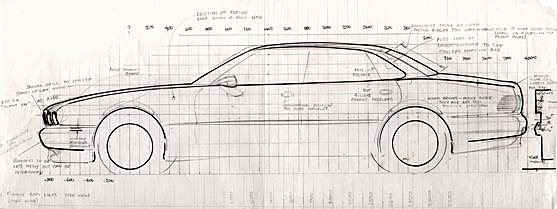 a typical feasibility scale drawing of a new Jaguar body style. Drawn here at eighth scale the design is drawn over a 200mm grid, and over existing packaging hard points . .
a typical feasibility scale drawing of a new Jaguar body style. Drawn here at eighth scale the design is drawn over a 200mm grid, and over existing packaging hard points . .
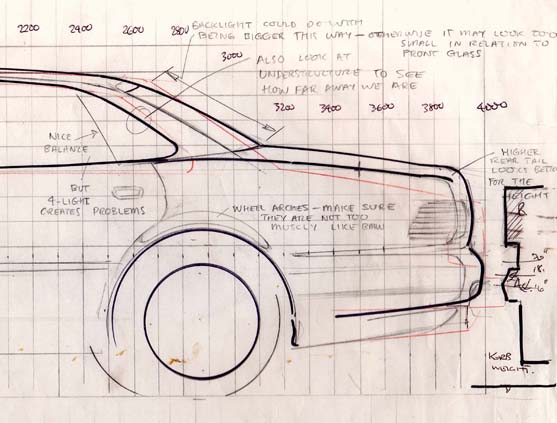 this particular design shows a boot lid over 4" higher than the XJ40 (XJ40 is shown by the thin red line) the federal bumper testing rig shape and also pertinent notes and comments
this particular design shows a boot lid over 4" higher than the XJ40 (XJ40 is shown by the thin red line) the federal bumper testing rig shape and also pertinent notes and comments
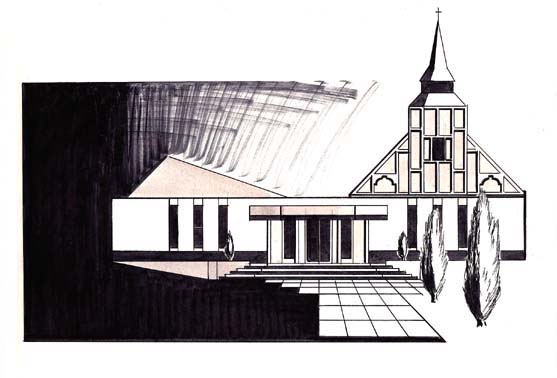 a visualisation of the building extension to Bethel Church in 1978
a visualisation of the building extension to Bethel Church in 1978
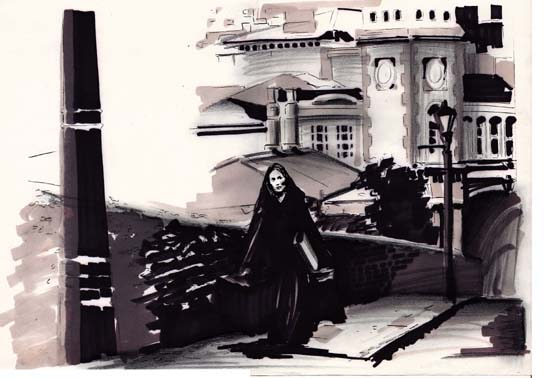 Meryl Streep in search of an Exeter hotel in "The French Lieutenant's Woman" . . a quick sketch done mainly with magic marker.
Meryl Streep in search of an Exeter hotel in "The French Lieutenant's Woman" . . a quick sketch done mainly with magic marker.
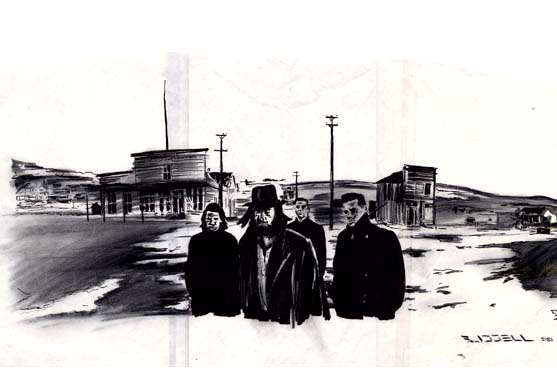 U2 pose as gunslingers during The Joshua Tree period.
U2 pose as gunslingers during The Joshua Tree period.
